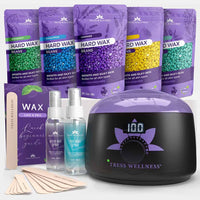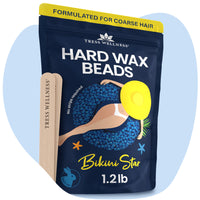Pimples after waxing can turn the joy of hair-free skin into a challenge. These irritating bumps, often referred to as folliculitis, are nothing to worry about, and they’re preventable. Stay tuned as we dive into why they occur and how to keep your skin smooth and clear with proven treatments and preventative measures.
Key Takeaways
-
Waxing pimples are usually small red bumps caused by folliculitis or skin inflammation; they’re not like regular acne and can indicate mild infection if white or fluid-filled.
-
Pre-waxing prep is crucial: You should exfoliate, hydrate (but no lotion right before), and use non-fragrance cleansers to minimize irritation and prevent post-wax pimples.
-
Post-wax care involves using soothing agents like aloe vera and witch hazel, gentle exfoliation to prevent ingrown hairs, and wearing loose clothing to reduce skin irritation.
Unveiling the Mystery: What Do Waxing Pimples Look Like?
Picture this. A day or two after your waxing appointment, you start to notice a cluster of small red bumps appearing on your once-smooth skin. These post-waxing bumps, often due to folliculitis, aren’t your run-of-the-mill pimples. They’re the outcome of bacteria taking a joyride in your damaged hair follicles.
But wait, there’s more. Sometimes, these bumps could just be a result of skin inflammation, looking like a rash which generally resolves on its own. However, if you see white or fluid-filled bumps persisting, it could indicate a mild infection like folliculitis.
Now that we’ve demystified what waxing pimples look like, let’s delve into why they occur.
The Root Cause: Why Pimples Appear Post-Wax
When your hair gets ripped out by wax, your skin goes through some serious stress, which can lead to irritated skin. This can cause mild bumps and inflammation. At times, folliculitis steps into the picture, causing itchy bumps that may resemble acne, as it affects the hair follicle when hair grows back.
Some common causes of itchy and irritated bumps after waxing include:
-
Allergic reactions to allergens or irritants in waxing products
-
Dehydrated skin overcompensating by producing excess oil post-waxing, increasing the likelihood of acne formation
-
Tight clothing that can trap bacteria against the skin, leading to further irritation or potential skin infections.
Immediate Response: First Steps After Noticing Post-Wax Pimples
If you spot post-wax pimples, don’t panic! Here’s what you can do:
-
Gently cleanse the skin with soap and warm water, then pat it dry.
-
Apply a cold compress to provide soothing relief and reduce inflammation.
-
Consider using a cortisone cream to further reduce inflammation.
While it’s tempting to pick at the affected area, resist the urge. Excessive touching can further inflame the area and exacerbate your post-wax pimples. If over-the-counter remedies aren’t working and the pimples persist or show signs of infection, it’s time to seek medical advice.
1. Your Pre-Wax Prep List
Before you step into the waxing salon for your hair removal appointment, there’s some prep work to do. First on the list? Exfoliation. Two to three days before your appointment, gently exfoliate the area with a sugar scrub or body brush to remove dead skin and expose any lurking ingrown hairs.
Hydration is key as well. Keep the area to be waxed well-hydrated in the days leading up to your appointment. But remember, skip the moisturizer on D-day to ensure better adherence of the wax. Use a high-quality cleanser to minimize bacteria on the skin. Avoid products with fragrance or makeup immediately before waxing to prevent further irritation.
Before waxing, follow these tips for the best results:
-
Select non-comedogenic skin products to prevent clogged pores and reduce the risk of irritation.
-
Refrain from using retinol in the days leading up to waxing.
-
Check your hair length. It should be at least the length of a grain of rice (around 1cm) before waxing for optimal results.
- Use the Tress Wellness pre-wax spray to prep your skin for effective waxing results.
2. Post-Wax Care: A Guide to Keeping Skin Clear
Now that we’ve covered the pre-wax checklist, let’s move on to post-wax care. This is crucial to treat and prevent skin issues, keeping your skin clear and preventing those pesky pimples from popping up. Here, we’ll zero in on two key aspects - soothing agents and gentle exfoliants.
Soothing Agents
Aloe vera gel is a godsend for post-wax skin, and witch hazel is another beneficial ingredient. Its benefits include:
-
Anti-inflammatory properties
-
Fragrance-free composition
-
Soothing the skin and reducing post-waxing inflammation, which helps to soothe irritated skin
-
Acting as a great moisturizer that can keep your skin hydrated without causing additional irritation.
If you’re looking for a cooling effect, tea tree essential oil gel is a great bet. It can be immediately applied after waxing and helps reduce the risk of infection. Products containing Calendula and tea tree extract, such as the Calendula pre and post wax care bundle, are also recommended for their antiseptic properties and soothing effects on the skin. The Tress Wellness after-wax spray is packed with skin-soothing ingredients like allantoin which calms the skin down after waxing.
Gentle Exfoliants
Post-waxing, your freshly waxed skin needs gentle exfoliation to remove dead skin cells and debris without causing inflammation. It’s important not to irritate freshly waxed skin, so consider using a mild scrub or an exfoliating cloth every other day to avoid the accumulation of dead skin cells. This can help to maintain smooth and healthy skin.
Sugar scrubs are an excellent choice for post-waxing care, as they help soothe irritation and prevent ingrown hairs, making your waxing experience smoother and more comfortable.
3. Wardrobe Wisdom: Dressing to Reduce Irritation
What you wear post-waxing can make a significant difference in your skin’s reaction. It’s important to wear loose, comfortable clothing after a waxing session, allowing your skin to breathe and reducing the risk of irritation.
For the first 1-2 days after waxing, stick to loose clothing and cotton underwear. This helps prevent rashes, redness, and breakouts. Avoid tight clothing as it can exacerbate folliculitis by causing further irritation to hair follicles, leading to an increased risk of bumps and pimples.
4. Advanced Tactics: Preventing Ingrown Hair and Pimples

To prevent ingrown hairs and pimples, schedule your waxing appointments four to six weeks apart. This allows the hair to reach the optimal length for waxing, reducing the likelihood of sensitivity and breakouts.
If skin irritation persists nearing your scheduled waxing appointment, consult with your waxing specialist. They can help determine if rescheduling is necessary to avoid further skin complications. Remember, ingrown hairs result when hairs curl back into the skin instead of growing outwards, causing itchy and painful pimple-like bumps.
5. Lifestyle Adjustments for Better Waxing Results
Your lifestyle choices can significantly affect your waxing results. Dietary changes, for instance, can enhance skin health, leading to fewer breakouts after waxing. Consuming foods high in antioxidants and water content and limiting intake of sugars, white flour, and hormone-laden meats can prevent post-wax breakouts.
Timing your workouts in relation to waxing appointments can also benefit skin health. By avoiding excessive sweating shortly after waxing, you can reduce the risk of acne.
5. Tress Wellness's Expert Recommendations
As experts in waxing, Tress Wellness recommends the following tips for a successful waxing experience:
-
Start with smaller quantities of wax and avoid waxing large areas at once, especially for those new to waxing.
-
Keep your skin dry during waxing to achieve better results. Consider using a fan to prevent the wax from becoming too sticky and to facilitate smoother application and removal.
-
If you’re new to waxing or have sensitive skin, practice with the wax on less sensitive body parts like arms or legs before moving on to more delicate areas.
-
Don’t forget to use a pre-waxing spray. It prevents hair breakage and ingrown hair that might be causing pimples and bumps.
Summary
In conclusion, pimples post-waxing can be a nuisance, but they’re not unbeatable. With the right knowledge and care, you can effectively manage and prevent these pesky bumps. From understanding what waxing pimples look like, why they occur, to immediate remedies and pre and post-wax care, we’ve covered it all. Remember to wear loose clothing, make lifestyle adjustments, and follow expert advice for the best waxing results.
Frequently Asked Questions
What do waxing pimples look like?
Waxing pimples usually look like small, red, tender bumps on the skin. Be careful if you notice them after waxing.
Why do pimples appear after waxing?
Pimples can appear after waxing due to skin stress, folliculitis, contact dermatitis, or excess oil production. This happens when hair is pulled out during waxing, causing skin irritation.
What should I do if I notice pimples after waxing?
If you notice pimples after waxing, gently cleanse the area, apply a cold compress or cortisone cream, and avoid touching the affected skin. Take care!
How can I prevent pimples after waxing?
To prevent pimples after waxing, make sure to take proper pre and post-wax care, wear loose clothing, and make lifestyle adjustments for healthy skin.
What are Tress Wellness's expert recommendations for waxing?
Tress Wellness recommends using smaller wax quantities, maintaining dry skin, and practicing on less sensitive areas for the best waxing experience. Start with these expert tips for smooth and effective waxing.





